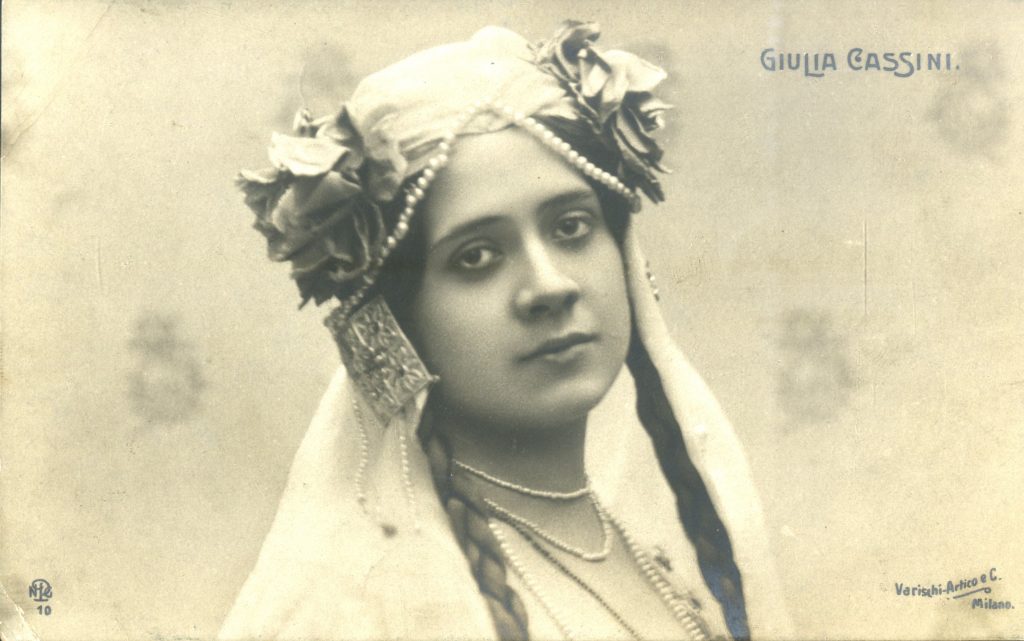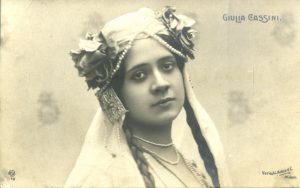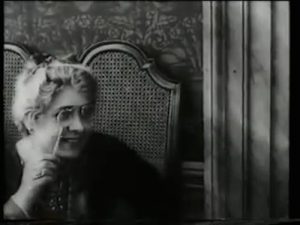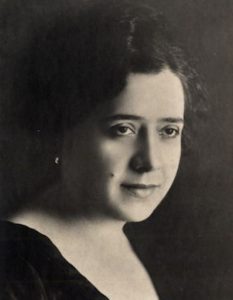One of the most renowned theater actresses, film actresses, and film acting teachers of her time, Giulia Cassini-Rizzotto was also one of the few female film directors it Italy during the silent cinema era. Possessing wide-ranging interests, she was also engaged in other activities, such as screenwriting and producing, as well as teaching nursery school and authoring short stories. Additionally, she was a correspondent for South American newspapers and a French translator (M.P.R. 1916, 19). Like many of her contemporaries who were involved in both theater and film, Cassini-Rizzotto’s cinematic career was shaped by her theatrical endeavors.
A child of artists, Cassini-Rizzotto was born into a family of theater actors on June 15, 1865. Her father, Giuseppe Rizzotto (1828-1895), was a well-known Sicilian dialect actor who was part of Giacinta Pezzana’s troupe during its South American tour in 1873 and 1874. He was then capocomico [director] of his own modest theater company and also ventured into playwriting with plays like “I mafiusi de la Vicaria” (1863). His works garnered interest when they were performed by Giovanni Grasso Sr. and then translated into the Milanese dialect and inserted into the repertoire of Edoardo Ferravilla’s theater company (Becherini 1954, 1035; Pieri 2000, 1099). Cassini-Rizzotto’s brother, Salvatore, who died at age forty-five during World War I, acted in prestigious theater companies and alongside the actress and capocomica Italia Vitaliani, the cousin of Eleonora Duse.
It was within this stimulating artistic environment that Cassini-Rizzotto grew to adulthood and received her initial theatrical training, making her stage debut in her father’s company. Throughout the end of the nineteenth century and the beginning of the twentieth, she worked with some of the greatest actors in Italian theater, including Grasso Sr., Ermete Novelli, Virgilio Talli, Irma Gramatica, Ruggero Ruggeri, Gualtiero Tumiati, and Ermete Zacconi. Her time with Talli is particularly significant because of the influence that he had on her future film work. Wanting to move away from strict textual analysis and rigorous work on performance style common in nineteenth-century theatrical traditions, Talli trained his actors to engage actively with their characters, forcing them to abandon the repetitiveness of superficial performance traits in favor of seeking out a deeper truth (D’Amico 1985, 137; Alonge 1988, 217-218). Cassini-Rizzotto’s apprenticeship with him allowed her to experiment with a comprehensive approach to acting, which combined a highly theatrical/expressive performance style with an experienced attention to staging. This approach would become a rule of thumb in her later film directing.
Giulia met Alfonso Cassini (1851-1921), an esteemed dramatic tragedian, through Ermete Novelli. They were married in 1902, and would go on to have two children together (“La morte di Alfonso Cassini” 58). Alfonso held the role of generico [bit-part] and caratterista [character actor] in the companies belonging to Novelli and Talli. He was also an active film actor with various production houses. Giulia and Alfonso shared numerous professional experiences over the course of their lives, and, consequently, from a historiographic perspective—at least until the end of World War I—it is more effective to think about their theatrical and cinematic work as collaborative.
Cassini-Rizzotto enjoyed a long and noteworthy theatrical career. She was seen as an “esteemed actress” (Savio 1954, 187), and one of her most important stage performances was in “Figlia di Jorio,” the pastoral tragedy in three acts written by Gabriele d’Annunzio in 1903. (Cassini-Rizzotto did not take part in the 1917 cinematic adaptation directed by Edoardo Bencivenga.) The play debuted at the Teatro Lirico, in Milan, on March 2, 1904. It was presented by the Talli-Gramatica-Calabresi company, which had employed both Giulia and her husband since 1901. Giulia played the part of Splendore in the celebrated play and in its repeat performances (Valentini 1993, 301-334). With Talli-Gramatica-Calabresi, she and Alfonso worked intensively until 1905, as demonstrated by their constant participation in numerous productions carried out by the distinguished company. From 1906 to 1912, the couple acted with the troupe belonging to Tina Di Lorenzo and Armando Falconi. Following these theatrical experiences, they decided to turn their professional interests toward cinema (Ascarelli 1978, 483). Very little is known about their move into the world of film—a move that was quite natural for many theater actors at that time. As far as we know, Giulia’s theatrical career came to an end once she started working in cinema.
We can confirm that Cassini-Rizzotto made her film debut, at the age of forty-seven, in 1912, assuming secondary and maternal roles. Her first films were with Latium Film in Rome, a company that had already hired numerous theater actors. Her early work included Il passato che non perdona, Redde rationem, Capriccio fatale!, and Il segno indelebile, which were all heavily emotive melodramas produced in 1912.
By 1913, the Cassinis were working for Roma Film, where they acted in Il romanzo di Luisa that year. Cassini-Rizzotto had a secondary role, playing Liliana, a beautiful woman who steals the main character’s partner. In 1914, the couple moved to Etna Film in Catania, Sicily, which at the time was considered an excellent production company due to the quality of its equipment and its technical-artistic staff (Bernardini 2015, 301-309). At Etna Film, Cassini-Rizzotto was hired as a leading lady and received acclaim for her portrayal of Xenia in Christus/La sfinge dello Jonio (1914), directed by Giuseppe De Liguoro. In the film, Xenia is a powerful woman from Syracuse, Sicily, who, in the year 1000 A.D., lived despotically in the lap of luxury. A critic for La Cine-Fono wrote that Cassini-Rizzotto “exceeded all expectations in her fantastic interpretation; one that won’t soon be forgotten” (Olleja 1915, n.p.). In La Vita Cinematografica, Pier da Castello stated that the performance of “Mrs. Cassini-Rizzotto has moments of eroticism, inebriation, fury—dangerous manifestations, artistically speaking, which can easily deviate an actor and an actress even more—[and] are treated with great measure” (1915, 63).
The Cassinis continued working at Etna Film for the next few years, appearing in Gian Orlando Vassallo’s Paternità (1914) and Anton Maria Mucchi’s Pulcinella (1915). In the latter, Giulia played the wife of her husband’s character, the honest young puppeteer after whom the film is named. The couple also acted together in De Liguoro’s Patria mia! (1915).
In 1915, when Italy entered World War I, the couple returned to Rome and began collaborating with Tiber Film. Cassini-Rizzotto made a supporting appearance in Baldassarre Negroni’s La signora delle camelie (1915) alongside Hesperia (the pseudonym of actress Olga Mambelli). The film was made at the same time that Gustavo Serena and Francesca Bertini at Caesar Film were producing their own adaptation of the same source material by Alexandre Dumas fils. Tiber Film’s version was deemed an act of unfair competition and this led to one of the first famous legal trials in the cinematic world, paving the way for important debates on intellectual rights in the field (Martinelli 1992, 12:194-197; Soro 1935, 77-95). After this episode, Cassini-Rizzotto continued to work with Tiber Film. Her films there included the aristocratic drama Primo ed ultimo bacio (1916), directed by the promising young Gennaro Righelli, who would also direct her in the carefree comedy Alla Capitale! (1916), and Negroni’s Gli onori della guerra (1917), a love triangle set in France based on the vaudeville by Charles-Maurice Hennequin.
Following their collaboration with Tiber Film, the Cassinis moved on to work with Società Italiana Cines, an important production company specializing in historical films (Bernardini 2015, 18). Cassini-Rizzotto acted alongside Lyda Borelli in La falena (1916) and Malombra (1917), both directed by Carmine Gallone. She also appeared in La bella salamandra (1917), which was shot in the Roman studios by the young director Amleto Palermi. La falena was only recently restored, in 2017, by the Cineteca Italiana di Milano, while Malombra was restored by the Cineteca di Bologna in 1991. In the latter, Cassini-Rizzotto plays the part of Contessa Salvador with an impressive naturalness. She gracefully assumes the role of the elderly woman, providing a nuanced performance that is entirely devoid of pretense. That Cassini-Rizzotto sought plausibility in her acting set her apart from the highly stylized performances embodied by many of the Italian divas at the time.
In Fabiola (1918), directed by Enrico Guazzoni for Palatino Film, Cassini-Rizzotto played the part of Lucina, the mother of a young Christian named Pancrazio who was persecuted in pagan Rome in 302 A.D. At the start of the film—fortunately, numerous copies have survived and are held in various archives—we can see Giuila’s uncertain gestures, painful and measured, as Lucina gives her son the cruet containing the blood of her husband, who had also died because of his faith. Although limited to just a few sequences in the film (including the memorable scene where she bids farewell to her son before he is killed by wild beasts in the Roman circus), the actress’s bravura is evident as she balances the impulses of such a melodramatic character with the needs of the script. What emerges is yet another expressive performance striving for believability.
As World War I came to an end, Cassini-Rizzotto took her career in a new direction. In 1918, she dedicated herself to teaching at Ars Film in Rome, one of the first schools of cinematic acting, producing actresses like Irene Saffo Momo, Claretta Rosai, and Lia Formia (Mattozzi 1920, 220; Dall’Asta 2008, 319). The school had likely been established by 1914 (Savio 188; Bernardini 2018, 80). Giulia had opened another school in Florence in 1916, called Artistica Scuola Film, which would become one of the most renowned cinematic acting academies during the 1910s (Alovisio 2005, 204n117). News reports of the time abound with remarks on the quality of the acting training provided, which at the time was defined as “a new art” (M.P.R. 14). The founding of Cassini-Rizzotto’s school in Florence had been considered a daring business venture as there was a high probability of failure, but it enjoyed the support of her friends and colleagues from the outset. Many held Cassini-Rizzotto in high regard for her sweet persuasiveness and artistic skill, which were features that made her a “very earnest teacher” (M.P.R. 20).
The proliferation of film schools in Italy during this period was an important signal of the industrialization of film production, as well as a trend toward professional specialization. It is within this context that Cassini-Rizzotto decided to test her mettle as a director, becoming one of the first Italian women to work behind the camera. She directed five films between the end of World War I and the early 1920s, which was not a favorable period for production in the Italian film industry. Unfortunately, only two films survive (Leonardo da Vinci from 1919 and A mosca cieca from 1921) and there is very little information about this period in her career in the specialized film magazines of the time. As a result, we know very little about the artistic and critical success of her directorial work today.
Her directorial debut was Scugnì (1918), self-produced by Casa Cassini-Rizzotto and written by and co-starring Alfonso. The story involves the misadventures of a poor young man from Naples, whom Cassini-Rizzotto had actually met. The part of the main character was given to Franca Di Leo, one of her students (Dall’Asta 319).
In 1919, in collaboration with the journalist and film director Mario Corsi, Cassini-Rizzotto directed Leonardo da Vinci. Inspired by the life of the celebrated painter, the film was produced by an obscure production company called Historica Film. The film enjoyed a degree of success and international distribution that included the Scandinavian countries (Dall’Asta 319-320). News reports from the time emphasized Corsi’s grand scenography, along with film’s remarkable historically-accurate set reconstructions. These elements were accentuated in part by an impressive system of stereoscopy designed and created by Lamberto Pineschi that was utilized to increase the 3D effect of the images (Brunetta 2008, 265). Pineschi and his brother, Azeglio, had founded the Società Italiana Pineschi in 1907, which became Latium Film in 1909, where Giulia and her husband had previously worked. The surviving copy of Leonardo da Vinci, held at the Cineteca Nazionale in Rome, offers a chance to witness what a critic at the time deemed rather unrealistic acting (Ruffo-Marra 1923, 61). The actors appear so intent upon representing the characters of the past that they are unable to convey natural sentiments, passions, and actions in a convincing manner. Interest in the film today lies mainly in its set design, the sumptuous costumes, the settings in historical locations, and in the works of art that accompanied the life of Leonardo.
In 1920, Cassini-Rizzotto directed two more films, both produced by Perseo Film: Senza sole, in collaboration with Camillo De Rossi, and La piccola Manon, in which she also acted. The latter was well received by critics. For example, in La Rivista cinematografica, Aurelio Spada noted that the film was “conducted with grace […] with a measured calm in its scenes and effects,” that the “quality and intelligence of the artistic direction” emerged, and that the name Cassini was synonymous with “competence” (1921, 31). He also stated how the photography was appropriate, “the set decoration sober and tasteful and the outdoor scenes picturesque and beautiful.” He expressed slight disappointment at the leading actors, Lya Isauro and Alberto Monti, reasoning that if they had been more successful in their performances the film would have certainly acquired more value. In contrast, he praised Cassini-Rizzotto’s performance in the role of Duchessa d’Albenga, which successfully combined “the noble bearing of the matron with the most dramatic expressions of an indignant and sorrowful mother.”
In 1921, Cassini-Rizzotto directed her last production, A mosca cieca, which she also starred in and scripted. The film was a lively comedy produced by San Marco Film in Rome, a production company with hagiographic intentions financed by the Vatican and certain members of the Roman and Neapolitan aristocracy. A mosca cieca was filmed for charitable purposes and involved illustrious members of the city’s aristocracy acting alongside young unknown actors who were most likely students trained at Cassini-Rizzotto’s school. Overall, it is a modest film, although it includes a few enjoyably humorous scenes. Its first screening took place on March 17, 1921, at the Teatro Valle di Roma with an audience made up largely of Roman nobility (Martinelli 1996, 19:26). One of the few writers that reviewed the event stated that the amateur noble performers appeared “as experienced actors of the silent scene” and are “exceedingly charming, especially the two female protagonists” (Ugoletti 1921, n.p.) According to this writer, the set design was comprised of “the beautiful exteriors of Roman villas,” which were normally inaccessible to regular film production companies. However, the film was deemed irreverent by the religious members of the Società San Marco, and was immediately pulled from circulation. A copy of the film is held in the Cineteca Nazionale in Rome, and is available for viewing there.
After her husband’s death, in 1921, Cassini-Rizzotto continued to work in cinema for only a short time. She appeared in two films in 1923, when Italian film production was well into its period of crisis. Cassini-Rizzotto acted in Germaine, produced by Palatino Film, and Triboulet, the six-part period piece directed by Febo Mari for Società Italiana Cines. Following these productions, her work in European cinema came to an end. She moved to Argentina with a theatrical company run by Maria Melato, an esteemed theater performer, cinematographer, and radio broadcaster. Cassini-Rizzotto continued her work as an acting teacher there, opening a school for stage acting in Buenos Aires, which she would direct until her death on August 24, 1943. Although unlikely, we cannot rule out that Cassini-Rizzotto returned to the cinema in her later years—a hypothesis that would require further research in South American archives to confirm.




